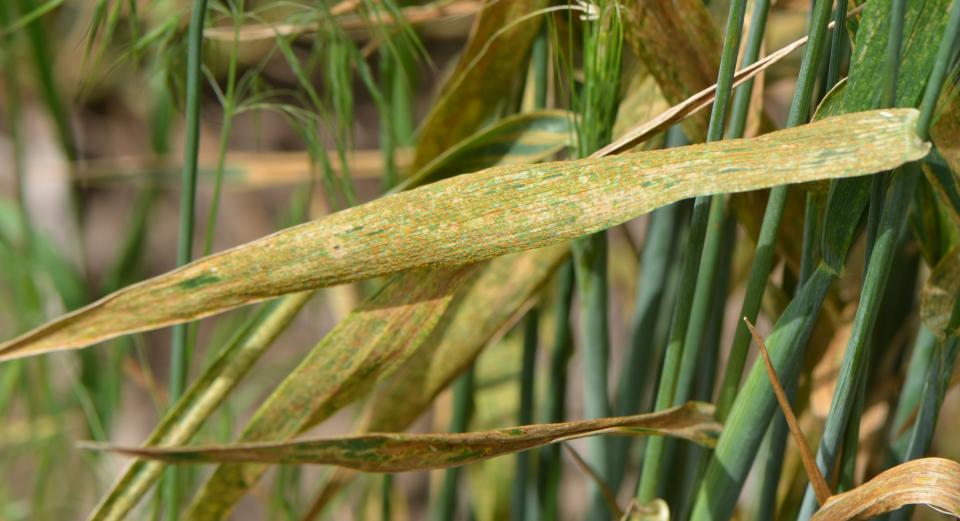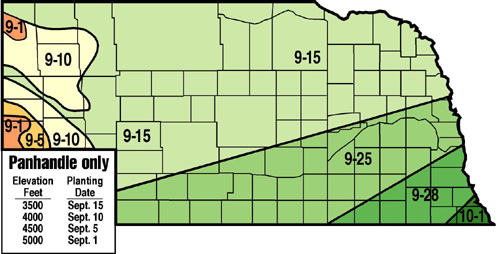
Fall Strategies for Managing Wheat Diseases
In the 2016 wheat growing season, stripe rust (Figure 1) was again (as in 2015) a predominant and widespread disease. In addition to stripe rust, other diseases can occur and cause losses in wheat. They include leaf spot diseases such as tan spot and Septoria tritici blotch; diseases affecting the grain such as Fusarium head blight (scab), common bunt (also known as stinking smut, Figure 2) and loose smut; bacterial diseases such as bacterial streak and black chaff; and virus diseases such as wheat streak mosaic which was severe in a few localized areas in the southern Panhandle in 2016 (Figure 3).
This article summarizes strategies that can be used in the fall to minimize losses during the 2016-17 wheat cropping season.

- Use certified, fungicide-treated seed. Certified seed is genetically pure, clean (no contaminants such as seed of weeds and unwanted varieties or off-types), and has a high percentage of germination. Genetic purity ensures that the variety you plant is the variety you get. Fungicide seed treatments reduce losses caused by seed-transmitted and soilborne fungal diseases of wheat. Some seed treatment products contain a fungicide and an insecticide and offer additional protection against fall diseases and insect vectors of disease, such as aphids.
Seedborne diseases controlled by fungicide seed treatments include common bunt and loose smut which replace the grain on the wheat head. Other seedborne diseases do not affect the wheat head, but cause seedling blights and root and crown rots. They include scab and black point. Soilborne diseases controlled by fungicide seed treatments include Rhizoctonia and Pythium root rots, common root rot, and Fusarium root and crown rots. Flag smut, which if found can prevent export of wheat grain to certain countries or markets, can be effectively controlled with fungicide seed treatments. In 2015 flag smut was found in several counties in Kansas, including some close to the border with Nebraska. - Control volunteer wheat and grassy weeds before planting. Volunteer wheat, especially that which emerges before harvest as a result of a hailstorm, poses a high risk for wheat streak mosaic and other wheat curl mite-transmitted virus diseases of wheat (Triticum mosaic and High Plains disease). This is because the volunteer wheat serves as a host for wheat curl mites and the viruses during the period between harvest and fall planting. If the volunteer wheat is not controlled before planting, the mites move from it to the fall-planted wheat and transmit the viruses, resulting in severe losses the following spring/summer. The mites can also survive on grassy weeds. Volunteer wheat and grassy weeds should be controlled so they are completely dead at least two weeks before planting.
- Plant at the recommended date for your area. Planting winter wheat too early lengthens the time when environmental conditions (warm temperatures and moisture) are favorable for development of fall season diseases such as root and crown rots, wheat streak mosaic, barley yellow dwarf, and leaf and stripe rust. Insect vectors of disease, such as aphids and wheat curl mites, have more time to transmit diseases if wheat is planted too early. Planting too late gives little time for wheat to establish itself before cold winter temperatures set in. This can result in weak plants that are vulnerable to attack by diseases in the spring. Therefore, it is recommended that winter wheat be planted at the recommended date for the respective wheat growing regions in the state (Figure 4).
- Consider disease resistance levels when selecting varieties. Some wheat varieties have good levels of resistance to certain diseases. Select varieties that have a good disease resistance package. Disease resistance information can be found in the 2016 UNL Fall Seed Guide, available online and in print from the Extension publications section of the UNL Marketplace. Stripe rust and Fusarium head blight ratings from the 2015 (multiple locations) and 2016 (one location) state variety trials are shown in Tables 1-5 (listed at right).
- Plant several varieties that differ in their genetics. Because of genetic differences, wheat varieties will react differently to diseases and some varieties will mature sooner or later than others. Planting several varieties with different genetic backgrounds, also known as variety complementation, is a strategy that can reduce losses due to diseases. For example, if only one variety is planted and it happens to be susceptible to a predominant disease during the growing season, for example stripe rust in 2015 and 2016, yield loss can be much greater than if two or three varieties were planted that have different levels of resistance.
Fusarium head blight, a disease that was predominant in 2015, provides another reason why it is better to plant several varieties that differ in genetic resistance. Because there is only a short window (flowering) when the Fusarium head blight fungus infects wheat, planting two or three varieties with different flowering dates increases the likelihood that one or two of them will escape heavy infections. - Plant into a well prepared seedbed. Planting into a firm, mellow, well-drained seedbed reduces damage caused by soilborne pathogens that cause root and crown rot diseases. These pathogens and the diseases they cause are favored by loose, compacted, or waterlogged soils.
- Do not spray for stripe and leaf rust in the fall. During the last few years, stripe rust and leaf rust have survived on volunteer wheat and some weeds such as jointed goatgrass (Figure 5) until emergence of fall-planted wheat. The diseases have then dispersed onto and infected the newly emerged wheat in the fall. It is not recommended to spray wheat for stripe or leaf rust in the fall. Instead, start scouting early in the spring and if you see stripe rust, be prepared to apply a fungicide to prevent its spread. If stripe rust appears on wheat in the fall, the chances are high that it will overwinter and start causing damage very early in the spring. In such a situation, an early spring fungicide application (even well before flag leaf emergence) is recommended.
- Use an integrated approach to manage wheat diseases. Integrating all or most of the disease management strategies available to you is the most effective approach to reducing losses in winter wheat. Use as many of the strategies outlined here as possible this fall to minimize losses during next year’s growing season.



State Variety Trial Disease Ratings for Wheat
Table 1. Stripe rust ratings in state variety trials in southeast Nebraska in 2015
Table 2. Stripe rust ratings in state variety trials in western Nebraska in 2015
Table 3. Stripe rust ratings in a state variety trial in the southern Panhandle in 2016
Table 4. Fusarium head blight ratings in state variety trials in southeast Nebraska in 2015
Table 5. Fusarium head blight ratings in a state variety trial in southwest Nebraska in 2015
Online Master of Science in Agronomy
With a focus on industry applications and research, the online program is designed with maximum flexibility for today's working professionals.
